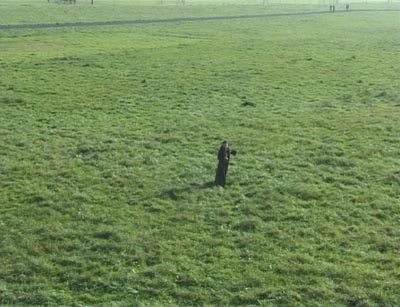 Maja Bajevic/Emanuel Licha: Videostill It ain't much but it's home Maja Bajevic, Emanuel Licha, Adrian Paci The recent work of these three artists questions the notion of home, as this place of intimacy, protected from the external threats, this place where we come from and where the heart remains whatever happens and wherever we are. Home brings with it very actual questions about belonging and roots, as well as interrogations on the ambiguous relations between the interior and the exterior, between private life and public world. Through autobiographical accounts or through fictions, each of these three artists reflects on what home is, be it remote because of emigration, or not clearly defined in space. A new video work by Maja Bajevic (*1967) and Emanuel Licha (*1971) will be projected in the gallery space. Maja Bajevic is filmed in a green field while describing her apartment in Sarajevo in which her grandparents and after them she herself lived before the war in ex-Yugoslavia. During the war people who up to now refuse to leave it occupied the apartment. The attempts to get this apartment back have remained unfruitful up to now, even though "official laws" exist for the restitution of the occupied apartments in Sarajevo. Maja Bajevic hasn’t been in her apartment for more than 10 years, but in her filmed description she tries to remember it with great details, and she moves in the field as she would walk in it: she goes from one room to the other, describing it and telling anecdotes. The attempt to rebuild mentally this space is laborious, and to orientate herself in this field is difficult. We get the feeling, through the intensity and precision of this description that home inhabits us as much as we inhabit it. Adrian Paci (*1969) is an Albanian artist living in Milano. In his work he questions the links that exist between the immigrant and its country of origin: links of the memory, of family, of custom. At Binz 39 he will present a video installation made of two projections on two opposite walls. On one we see his small daughter sing a traditional Albanian song. On the other projection we see a group of elderly people, all member of Adrian Paci’s family, singing along the same song. First, the child was filmed in Milano whereas the elderly people of the family where filmed in Albania while they were looking at the video of the child singing. It creates a moving "face to face", between two generations and between two places, the one of the origins and the one of the exile. Paci stands between these generations and these places. Adrian Paci will also show a photograph from the series Back home on which we see a family posing in front of a painted décor of the interior of a home. This family is also Albanian and living in Italy. Paci asked them the permission to enter their abandoned house in Albania, took pictures inside, and back in Milano he painted on canvas a real-size scenery from one of these pictures. Then he invited the same family to come to his studio to be photographed in classical pose in front of the décor of their own house. A construction by Emanuel Licha will also be shown. It consists of a small house closed on every side. The only openings are made of narrow plastic tubes coming out of the external walls, from which different domestic sounds come out. These sounds suggest that there’s a life happening in this closed house, and this perspective is worrying. It’s the hidden side of intimacy. But why are the people living inside hiding? Or what are they hiding? Home may well protect, but it is also this place of hiding, disconnected from the outside world. A photographic work (Mise en scène: Father and Son) is placed beside this construction. It was originally taken to document a performance Licha did in 1997. It shows him wearing a very indecent costume made of red lace, from which a tube comes out at the level of his phallus. The tube is divided in two and it is possible to look in these two ends. The photo documentation of this performance was made in the artist’s studio, and Licha asked his father to play the role of the anonymous spectator. But this documentation photography carried much more weight than expected, suggesting a worrying family relation. The threat has now reached the family circle, and there is no more home that can protect us in an absolute way. Ausstellungsdauer: 9.3. - 6.4.2002 Oeffnungszeiten: Do-Sa 14 - 18 Uhr Stiftung Binz39 Sihlquai 133 8005 Zürich Telefon 01 271 18 71 |